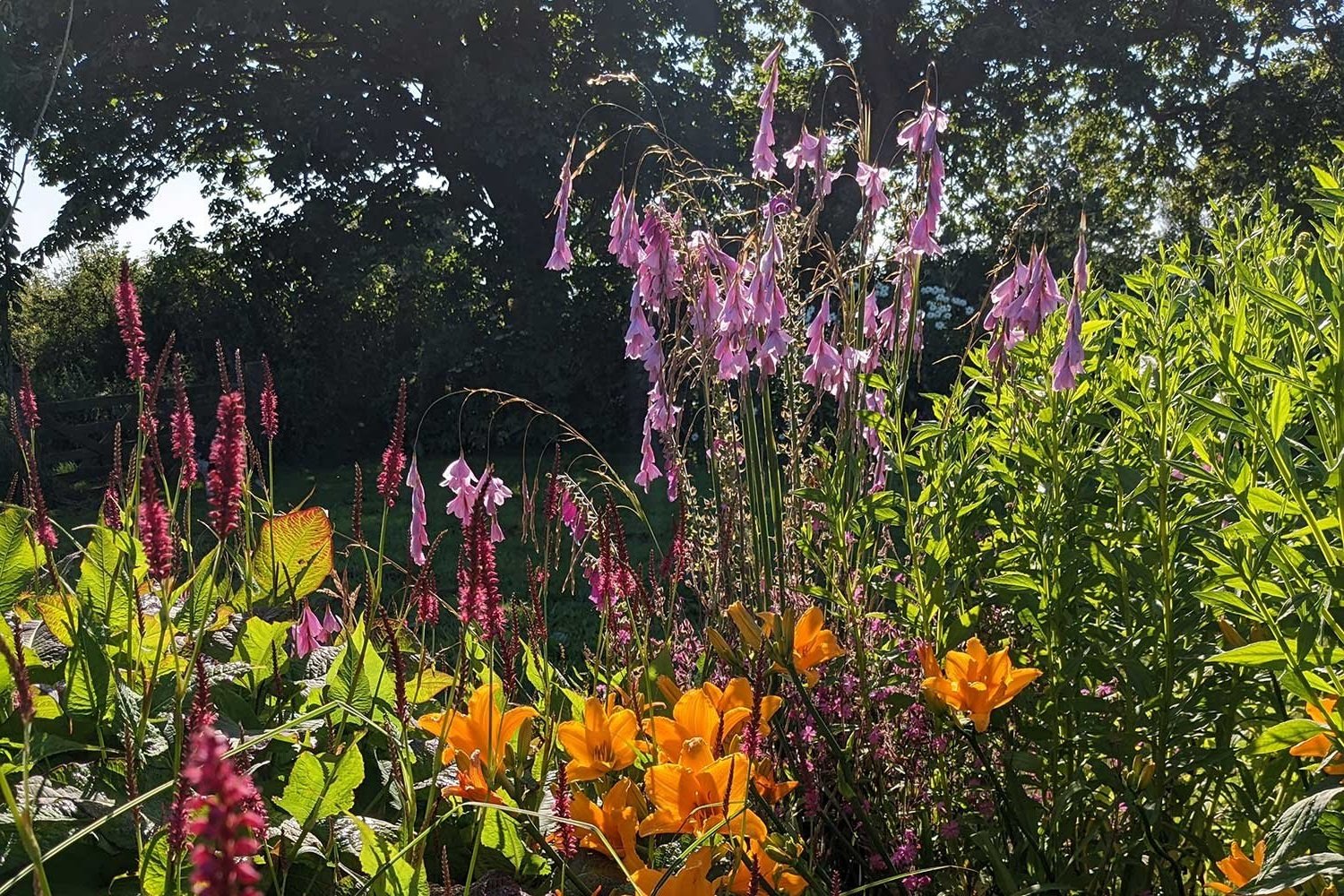The New Aesthetic in Landscape and Garden Design: Ecological design - reflections from a psychologist
I write this within the context of having studied and worked in psychology for 20 years, in academia and for the NHS, after a first degree in philosophy. I share reflections initially inspired by one of Catherine Heatherington’s early papers, Ecological Design: A new aesthetic, which I came across when I became a professional garden designer. The paper played on my mind and I thought perhaps a psychologist's perspective will be of interest? Take a look and decide for yourself!
What is Aesthetics?
When we talk about aesthetics, we’re generally talking about what we find beautiful, artistic, or tasteful. This could be with respect to anything created by humans or naturally occurring. In this article I’ll be focusing on gardens and landscapes which are a combination of the two.
We all differ in what we consider to be aesthetically pleasing. Our tastes often evolve over time and can change from moment to moment. When viewing a garden, we may be influenced by many factors e.g., our cultural background, our social context (who we’re with), and our mood at the time. We might also be influenced, consciously or otherwise, by current trends as seen in glossy magazines and on TV.
There have been many trends in landscape and garden design over the years from renaissance styles, to the arts and crafts movement, to the postmodern style. All of these fashions have had their own aesthetic. They have all been considered beautiful in their own, often very different, ways. So, what is the new aesthetic? What is the latest trend? The honest answer is that I’m really not sure. History will tell the tale as always, but I hope it will be ecological design.
What is Ecological Design?
Ecological design is an approach which gives particular attention to environmental impact. More specifically, ecological design focuses on minimising negative environmental impact. Clearly, this is a challenge, not least because it’s often difficult to know what impact your design is having or will have later down the line. As Society of Garden Designers (SGD) Co-Chair Lynne Marcus said “It is hard not to feel paralysed by the enormity of climate change”. This is a normal and understandable reaction for all of us.
We can only do our best, within reason, to navigate the often-conflicting information we have access to. Frameworks such as The SGD Manifesto for Sustainable Landscape and Garden Design and Environmental Action Plan can help. Sustainable design being about ‘meeting the needs of the present without compromising the ability of future generations to meet their own needs’ according to The United Nations Brundtland Commission.
So, ecological and sustainable design are not ‘looks’ as such, they do not necessarily share a single aesthetic, they are more principles and approaches. Nevertheless, some people believe that ecological design must mean sacrificing aesthetics for sustainability. It is hard for some people to believe that a thing can be both beautiful and environmentally friendly.
Unfortunately, expectations can often become self-fulfilling prophesies as we consciously or not, tend to look for information which confirms our own beliefs (confirmation bias). This helps us to feel safe and secure - a basic human need which I will return to later in this article.
The New Aesthetic in Landscape Design
I first came across the concept of ecological design being ‘a new aesthetic’ in landscape design via a thought provoking article written by garden designer and consultant, Catherine Heatherington. Unfortunately the article is no longer available online, possibly because it was one of her early pieces. Nevertheless, I felt it was valuable and thought provoking. In the article, Catherine notes that the British typically associate sustainable landscapes with an aesthetic of heritage and preservation, rather than an aesthetic of exciting contemporary design which might for example involve naturalistic planting and/or brownfield wildlife habitats.
Relatively modern urban sites may not easily lend themselves to a traditional heritage and preservation approach. Furthermore, whilst some of us might have no difficulty in finding beauty in heritage and preservation, some of us might understandably prefer a more modern aesthetic, particularly in our own gardens.
In her article, Catherine suggests that ecological design can be contemporary and exciting. She provides examples of the approach taken to derelict industrial sites in Germany such as the Landschaftspark Duisburg-Nord, a coal and steel production plant until 1985, redesigned by Peter Latz and Partner.
Importantly, Catherine quotes Anna Jorgensen’s wise words that if the benefit of an ecological, naturalistic approach ‘is not accepted by those that have to live, work and play in such a setting, then these plantings can never be truly sustainable’. I think this speaks to the more general point that if we don’t value a space, we will not sustain it, we will not care for the space or support it to evolve over time.
So how can we come to accept a more contemporary approach to sustainable design when the traditional heritage and preservation approach doesn’t work or isn’t accepted? In her article, Catherine states that ‘for more adventurous sustainable projects to be accepted by the public they must also be understood by those that use them’. So, in what way do we need to ‘understand’ a landscape?
Understanding Landscapes Rationally
Catherine explains the success of sites like the Landschaftspark Duisburg-Nord using the framework provided by Louise Mozingo. Mozingo, challenged ecological designers to consider the qualities of visibility, temporality, reiterated form, expression and metaphor. Very interesting and clearly valuable but pretty intellectual stuff aimed at designers rather than users of a space.
With regards to the people who use a space, Catherine provides various examples of how we might rationally understand landscapes. She talks about Mozingo’s observation that the metaphor-rich nature of ecological design can lead us to ‘ah ha’ moments. For example, we might think about the destruction of industry when we see plants taking over a former working industrial site.
Catherine also cites James Hitchmough’s experience of people becoming more tolerant of the appearance of naturalistic vegetation in winter (which they previously found messy), when they understood that a mass of colourful flowers would follow in the summer. By understanding some of the processes involved, in this case the seasonal changes, we can come to see the value in aspects of ecological design which we might previously have found challenging.
Likewise, we might judge a small wetland area in our local park negatively if we don’t understand some of the processes involved. It might look a bit wild and a poor use of space. However, when we understand how it is a Sustainable Drainage Solution (SuDS), helping solve the problem of water runoff from local roads, reducing pollution, reducing flooding, avoiding water scarcity, and increase biodiversity, we might see more value in it.
There is certainly value in starting conversations and encouraging people to take an interest in the ecological processes involved in sustainable landscape design. Some of us will certainly be interested, and spread the word. But unfortunately, those of us who aren’t interested run the risk of having our belief that sustainability necessarily means ‘messy’, confirmed. So how can ecologically designed landscapes best appeal to all?
Understanding Landscapes Intuitively
As a psychologist, I’ve had the privilege of meeting a huge range of different people. Early in my career, whilst volunteering with a drug and alcohol detox centre in central London, service users explained to me that they wouldn’t want to go to Dartmoor because ‘anyone could come up behind you’ on the wild moor with no streetlights. This was eye-opening for me. Having grown up in Cornwall, I considered the remote countryside in all its forms to be my place of safety day or night (and felt pretty vulnerable on the bright, noisy streets of London).
As humans, we are hard wired to be wary of the unfamiliar and that which we don’t understand. Wild environments are unfamiliar to many and hence may seem chaotic, unpredictable, threatening and out of control. Certainly not aesthetically pleasing. Feelings may range from discomfort at the perceived lack of care (e.g. ‘what is the world coming to’ thinking), to anxiety about our children’s safety, to outright fear that someone might jump out from behind a bush and attack us.
Seeing ecologically designed landscapes in the media is likely to help ease our concerns if only through a sense of increased familiarity with such landscapes. But what about the people who are not exposed to this sort of media or for whom this isn’t enough? How can the landscapes themselves help?
In her article, Catherine considers how landscapes communicate to us. She discusses Mozingo’s call for contrast with the natural environment so that we can easily see what a space is not - undesigned. But why is this important? For me, this fits with Joan Nassauer’s ideas about ‘cues to care’ (also mentioned in Catherine’s article). The idea that a bit of the well-ordered familiar (e.g. mown paths, clipped hedges, paving), might signal to us that someone intends to care for an otherwise wild space and that the space should be cared for.
It makes sense to me that we might be reassured to feel that caring people have designed and gardened the space we’re in. Equally, we might ‘understand’ that the environment is safe and meant to be that way if we see well maintained utilities like cycle paths or children’s play areas. There is obviously an important role for professional gardeners and grounds keepers as well as designers here.
This sort of understanding is not taught. It is an automatic response to a well-designed space, a feeling of comfort, almost intuitive.
Enjoying Landscapes
I’ve been struck by John Little’s view that people need to enjoy ecological design for it to be successful. In her article, Catherine also acknowledges Mozingo’s belief in the importance of spaces being incorporated into our day-to-day lives in pleasurable ways. So how does this fit with the idea that we need to understand spaces in order to value them?
As a psychologist, I’m very aware that our hearts often rule our heads. That is, we’re more likely to value something for emotional reasons than because rationally we know the thing to be of value. Understanding gained without joy is unlikely to be enough - it might even be off-putting. If we have enjoyed learning about the processes involved in an ecologically designed landscape, we’re more likely to value that landscape.
But is it always necessary to understand a landscape in order to value it? Do I understand much about the stars in the sky? No. Do I value them, love them, and think they are beautiful? Yes, absolutely. I enjoy looking up at the sky on a clear night and maybe my experience is even better because I hardly understand it at all. The sky is familiar to me, I see it every night, and I remain awestruck.
To experience joy, we need to feel sufficiently safe to be sufficiently relaxed. To enjoy the night sky, I need to be fairly confident that it won’t fall on me. To enjoy the ocean, I need to be fairly confident that I won’t drown in it. That’s not to say that a frisson of risk, of danger, might not add to my enjoyment! We are all different and we will all have different tolerances.
So, coming to understand the processes involved in an ecological design might be enjoyable for some, but understanding a thing can also make it seem more predictable, less chaotic, and hence safe to relax and enjoy. And perhaps we don’t always need that depth of understanding. Perhaps if we can understand more intuitively, just enough to feel relaxed enough to enjoy the landscape, we will value it and want to sustain it just the same.
The New Aesthetic in Garden Design
I feel the principals of ecological landscape design can be applied to garden design. After all, there is no strict difference between landscape design and garden design. Having said that, I tend to think of landscape design as concerning larger often public spaces, and garden design concerning typically smaller domestic spaces.
Garden designers can learn from the work of people such as Catherine Heatherington, Peter Latz and Partner, Louise Mozingo, John Little, Joan Nassauer, Anna Jorgensen, James Hitchmough and many more. With the help of frameworks such as The SGD Manifesto for Sustainable Landscape and Garden Design and Environmental Action Plan, we can adapt ideas used on a larger scale for use in smaller domestic gardens.
Larger ecologically designed public spaces and the publicity they get can help to increase our familiarity with ecological design and make it more likely that we will find such designs aesthetically pleasing. However, it is of course essential that garden designers meet the needs of their clients. If we agree to take on a project, we must be respectful of the client’s comfort zone. Whether you think it’s justified or not (I do not), trying to shame people into changing their behaviour/choices/taste is likely to backfire. We must meet the client where they are at. An empathic collaborative approach is likely to be most helpful.
It is completely understandable and important that you as a client want to enjoy your garden. The garden design process itself should be an enjoyable one. Whilst it is a garden designer’s job to present new ideas and possibilities, if you feel uncomfortable with what is being proposed, it is important you feel able to say so. If not, perhaps you need to find a new garden designer!
Conclusion
Landscape and garden design trends come and go, but right now, climate change means we all need ecological design. However, needing and wanting are different things. We might tolerate sustainable design better if we understand the ecological processes involved. But I think we might freely choose ecological design if we enjoy learning about those processes or simply enjoy being in the space itself.
The ecological design aesthetic can mean different things to different people. For some, ecological design may mean heritage and preservation, for others it may mean contemporary and exciting. We are all different and all have different interests and tastes. As a minimum, we all need to ‘understand’ enough about the space we’re in to relax and enjoy it. To be truly sustainable, ecological design should aim to make this basic level of understanding effortless for everyone.
The more we enjoy ecologically designed spaces large and small, and the more we see them publicised, the more time we will want to spend in them and the more familiar they will become to us. With any luck, in this way a new trend will grow as our sense of what is aesthetically pleasing naturally adjusts over time to favour ecological design in all its forms. What we once saw as ‘messy’ might come to seem beautiful!
This can’t be rushed though. As designers, we need to meet people where they’re at. As clients you can help by being willing to have a conversation about ecological design. Remember though that it’s natural to feel wary of the unfamiliar and understandable to want your garden to work for you first and foremost. Find a garden designer who can work with you to create a design you find beautiful, that meets your needs, whilst minimising harm to the environment and bringing joy to your life!
I would like to thank Catherine Heatherington for taking the time to provide thoughtful feedback on my first draft of this blog and for writing a paper which promted so much thought!
Please don’t hesitate to get in touch if you have a garden design project you’d like to discuss or if you’d like to book me as a speaker. I’d love to hear from you!
If you have any questions, if you think there is anything missing, or if there is anything else you’d like to see included, I’d welcome your comments below.









